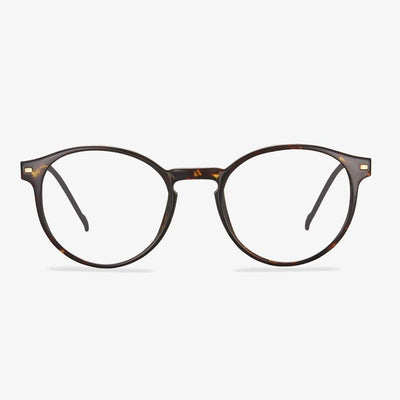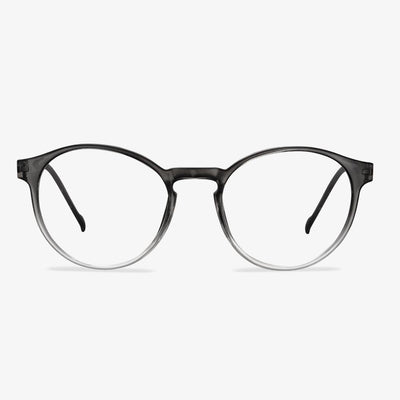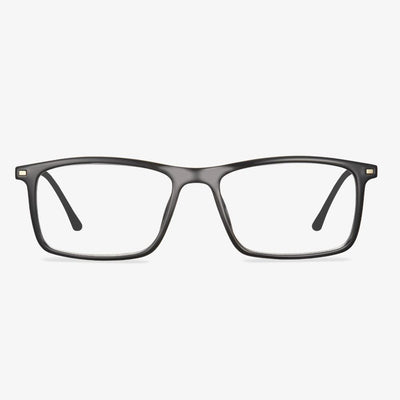The Benefits of Glasses Without Prescription
From the above part, you have found some basic information about glasses without prescription. In this section, we will list some benefits of plain glasses.
The non-prescription glasses are inexpensive, and they are widely available in a selection of styles and shapes. In addition, non-prescription glasses can be easily replaced as fashion changes.
Meanwhile, everything has two different sides. So, there are also some negative voices of glasses without prescription.
The discoloration principle of photochromic lenses
The fine grains of silver halide and copper oxide were melted into the glass melt of the lens blank material to produce the lens. When the lens is in the ultraviolet environment, the silver halide molecules will undergo a chemical reaction due to the ultraviolet radiation and decompose into silver ion particles and halogens. Because the silver particles are dark and absorb visible light, the lens gets darker. When the ultraviolet light is weakened or isolated, silver ions and halogens are recombined under the action of catalyst copper oxide to form silver halide, so the color of the lens gradually becomes lighter and transparent again. The discoloration mechanism of the resin lens is similar to that of the glass lens.
Why do spectacle lenses fog up?
The fog on the surface of the lens is essentially related to the saturation pressure and water vapor liquefaction. The air is full of water molecules, which are constantly doing irregular movements. When there is no temperature difference, water molecules keep hitting the surface of the lens and will keep bouncing off. The lower the temperature, the slower the speed of movement. Therefore, when water molecules hit the cold lens from the hot air, on the one hand, they move too slowly to fly out in time. On the other hand, because of the relatively low temperature of the lens itself and its vicinity, the water vapor will liquefy. As a result, more and more water will accumulate on the lens and form small droplets, eventually forming a foggy layer. As the lens heats up, the mist evaporates back into the air, and the fog disappears.
Why are rimless glasses so expensive?
Rimless glasses are the design vantage point in the frame of glasses. The structure of rimless glasses requires many higher physical features (flexibility, surface texture, etc.) and machining accuracy than TR, PEI, and other materials. In order to ensure comfortable wear, the common materials are very exquisite. And for processing technology, the frame is the most difficult. It's not just grinding, it's a full polishing, and it's perforating. This is the technical demand and the most time-consuming.
The origin of modern eyeglasses
The origins of modern glasses can be traced back more than 1,000 years. In the Middle Ages, the reading stones used by monks were glass spheres, sometimes filled with water and placed on objects to magnify them.Glassblowers in Italy created reading stones, similar to modern hand-held magnifying glasses. The reading stone can be placed on the wearer's nose or in front of the face. Later, Spanish craftsmen built the first cobra-framed temple in the 17th century. They tie ribbons or strings to the frames and tie them around the user's ear.
In the 18th century, Edward Scarlett created the first wearable glasses, providing more comfort for eyewear wearers. These early glasses had glass lenses embedded in heavy frames made of wood, lead, or copper. Natural materials of leather, bone, and horn were later used to make the frames. In the early seventeenth century, lighter steel frames were invented. As eyewear continued to evolve and prescription accuracy improved, the trend for eyewear to become more fashionable began. In the 18th century, bifocal lenses appeared, making it possible to correct upper myopia and lower presbyopia. Later glasses were designed to be fixed by a ribbon or by applying pressure to the bridge of the nose. In the 1980s, plastic lenses were introduced, providing a more durable alternative to glass lenses. Ultimately, the glasses used today are the result of centuries of technological and intellectual advances.
What Is Progressive Lens?
Progressive lenses, also called multifocal lenses, have three prescriptions in one pair of glasses. So, it allows you to see near, middle distance, and far objects without changing your glasses. The progressive lenses are designed for people who are over 40 years old who are both nearsighted and farsighted. The progressive lenses come with the following features:
- There is no distinct line between all visions(near, intermediate, and far).
- Most popular lens for anyone with presbyopia who wears
- Expanded intermediate zone for better computer vision.
From the above information, you may have known the differences between bifocal lenses and progressive lenses. As for progressive vs bifocal lenses, which one is better? It is difficult to judge because each of them has unique features. So, if you do not know choose which, you can listen to the eye doctor.
The purpose of glasses donation activities.
Regular social donation activities should be carried out in a planned way. For the poor in the rural areas of the disaster area and the poor in the urban districts, donations of materials or funds can not only feel the warmth and humanistic care of society in life and material, quickly resuming production and rebuilding homes. It gives them a sense of psychological security and stability, which is more practical than physical help.











































